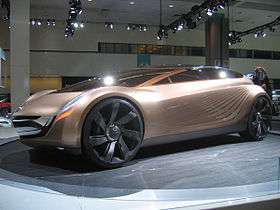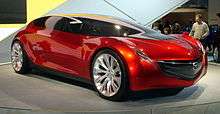Mazda Nagare (car design)
Nagare(流, flow) is an automotive design language created by Franz von Holzhausen and Laurens van den Acker for Mazda. These designs have been incorporated into concept cars, starting with the car of the same name. The Nagare design lineup was intended as a showcase of what Mazda's cars may have looked like in 2020.
| Nagare | |
|---|---|
| Overview | |
| Manufacturer | Mazda |
| Production | 2006-2007 |
| Designer | Franz von Holzhausen Laurens van den Acker |
| Body and chassis | |
| Class | Concept car |
| Related | Mazda Nagare Mazda Ryuga Mazda Hakaze Mazda Taiki Mazda Furai |
| Powertrain | |
| Engine | Mazda MZR engine Mazda Wankel engine |
| Chronology | |
| Successor | Kodo design language |
It was abandoned in 2011 by Mazda in favour of the Kodo design series, starting with their Shinari concept car.[1]
Motif and examples
The influence of the designs are wind and flow.[2] These can be seen in the cars' design, where areas of the cars contain flowing lines.
Production cars in Mazda's late-2000s lineup, such as the second-generation Mazda3 and Mazda6, could easily be identified by swooping leaf-shaped headlamps, while the third-generation Mazda Premacy had flowing lines sculpted into the bodywork.
Nomenclature
All concept vehicles have names in which represent Nagare's "wind and flow" theme in one way or another.
Concept cars


Mazda Nagare
The Mazda Nagare is the first car built under the Nagare design language, and shares the same name with the language itself. The car debuted in the 2006 LA Auto Show.[3]
The car takes the form of a long-wheelbase Kammback sports car. The futuristic interior is very irregular, with the driver placed front and center under the roof's highest point, and three additional passengers seated behind in a "wrap-around lounge". The Nagare also has butterfly doors that nearly span the entire wheelbase.[4] The Nagare's engine is non-existent, as it is not a running prototype.[3]
Designer Franz von Holzhausen mentioned during an interview at Autoblog, that he took inspiration from nature and pasted it onto the Nagare concept.[3] Some of von Holzhausen words are typed below:
"We began by studying motion and the effect it has on natural surroundings: how wind shapes sand in the desert, how water moves across the ocean floor, and the look of lava flowing down a mountainside. Natural motion registers an impression in your brain and that's what we hoped to capture with the new Nagare surface language. Once we started sketching our ideas, we weren't surprised to find similar quests underway in other product design disciplines. We found examples of motion influencing the shape and surface of furniture, architecture, apparel, and artwork. Nagare undoubtedly proves our confidence in identifying a new and exciting visual language for Mazda as we lead the way in defining the interaction of motion and flow in automobile surfacing."
Mazda Ryuga
The Mazda Ryuga is the second vehicle built under the Nagare series. The name Ryuga (流雅, gracious flow) references the purpose of the design. The car features gull-wing doors, and an entirely futuristic interior, hinting at Mazda's planned future in design. It is powered by a 2.5-litre Mazda MZR inline-four engine.[5]
Mazda Hakaze
The Mazda Hakaze(葉風, leaf wind) is the third car to be featured in the series. The car has a crossover body style with scissor doors, which make front and rear access easy. However, HVAC and radio controls are difficult to access, making them user-unfriendly. The seats are very pod-like, suggesting that the seats may be hooked onto the center console. Mazda said the car was more production-ready than the rest of the lineup.[6] It is powered by a 2.3-litre MZR engine.
Mazda Taiki
The Mazda Taiki is the fourth vehicle featured in the series. The name Taiki (大気, large atmosphere) is intended to complement the car's atmospheric canopy surrounding the driver and passenger. The rear wheels are set out from the body. The car's interior continues the flowing design theme. Power from the Taiki comes from an improved version of the 13B Renesis Wankel engine used in the RX-8.[7]
Mazda Furai
The Mazda Furai is the fifth and final car in the series. It is also the most storied and most popular Nagare-styled car.
The Furai is based on the Courage C65 LMP2 prototype that Mazda used for the American Le Mans Series.[8] The car runs on E100 ethanol, being the only rotary-powered car to do so. The engine is a midship-mounted R20B Renesis Wankel engine producing 450 hp (336 kW; 456 PS) and coupled to a 6-speed Xtrac semi-automatic transmission. The engine was built by company Racing Beat, who also made the rotary-designed muffler.[8] The name Furai (風籟, wind's sound) is also a reference to the Nagare "wind and flow" motif. The car wears the number 55 as a tribute to the Mazda 787B.
The Furai was tested on many circuits, such as Mazda Raceway Laguna Seca. In 2008, the car was destroyed after catching fire during a Top Gear photoshoot. This event was fully revealed to the public in 2013.[9][10]
References
- Patton, Phil (2011-05-20). "Mazda Designers Abandon Nagare, Embrace Kodo". The New York Times. ISSN 0362-4331. Retrieved 2017-06-12.
- "Mazda Nagare design language - Car Body Design". www.carbodydesign.com. Retrieved 2017-06-12.
- Neff, John. "LA Auto Show: Mazda Nagare Concept wedges into the spotlight". Autoblog. Retrieved 2017-06-12.
- "2007 Mazda Nagare". Top Speed. Retrieved 2019-12-16.
- "Mazda Ryuga news - Detroit show: Mazda Ryuga Concept - 2007". Top Gear. Retrieved 2017-06-12.
- Kaehler, Justin (2007-03-01). "Mazda Hakaze". IGN. Retrieved 2017-06-12.
- Holmes, Jake. "Mazda Taiki Concept". CarandDriver. Retrieved 2017-06-11.
- "Mazda Furai". www.racingbeat.com. Retrieved 2017-06-12.
- "Exclusive: how the Mazda Furai burned to death". Top Gear. Retrieved 2017-06-12.
- Mikeado. "The Mazda Furai Burned To Death In 8 Minutes, Hidden From Help". Oppositelock. Retrieved 2017-06-12.